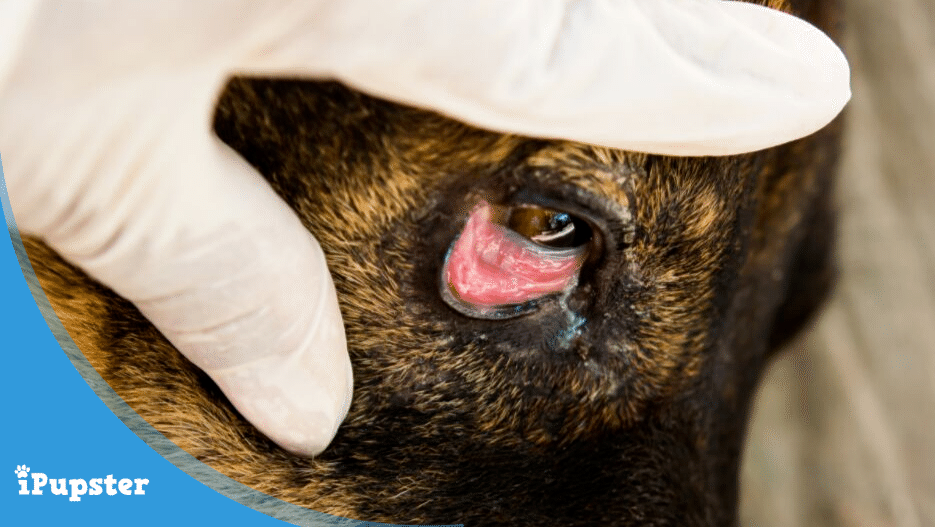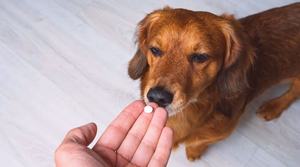
Reviewed & Fact-Checked by
Dr. Paula Simons
Veterinarian (DVM)
Learn more about our Veterinary Review Board »
Pinkeye. Properly known as conjunctivitis it may be something you have dealt with in the past. In humans, it is a fairly common eye infection.
What you may not know is that it is something that often affects dogs as well.
What is Conjunctivitis in Dogs?
Conjunctivitis found in dogs is similar, but not quite the same, as the condition found in humans. The conjunctiva is a mucus membrane found surrounding the eye to protect it from debris and damage.
It covers the whole eyeball and lines the eyelids as well.
Simply put, canine conjunctivitis is an infection or inflammation of that membrane.
It can be more complicated in dogs - and cats - than in humans, as they have a third eyelid, and so the potential infection has a greater area that it can spread to, increasing the pain and irritation a dog feels.
What Causes Conjunctivitis in Dogs?
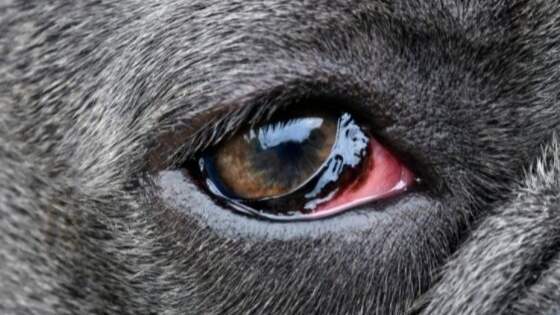
A 3-year-old Bulldog with a red right eye
Conjunctivitis in dogs can be caused in a number of different ways.
These include all the following risk factors:
- A viral infection such as canine distemper virus
- An allergic reaction to a medication
- An autoimmune disorder in the eye
- Blocked tear ducts
- An eye injury (especially a scratch)
- Entropion, a condition in which the eyelids roll inward
- A reaction to environmental pollutants like smoke, pollen or dust and dirt
- Chronic dry eye
- Ulcers in the eye, including the condition ulcerative keratitis
- An infection of the eyelash
- Dangers outside such as thorns from rummaging in bushes
- Unintended eye injuries from shampoo, scissors, drying and restraint can occur during your dog's grooming
Dog conjunctivitis is typically brought on by trauma, allergies, dirt, and chronic illnesses. One of the chronic causes is a condition known as "dry eye" or keratoconjunctivitis sicca which is more prevalent in small dog breeds.
Are Certain Breeds More Susceptible to Developing Eye Conditions?
Yes, and being aware of your pet’s unique risk for certain diseases may allow earlier detection and treatment.
Dr. Carol Osborne DVM at Chagrin Falls Pet Clinic states:
"Allergies are a major cause of conjunctivitis in dogs. Dogs overly sensitive to pollen, dust and mold often rub and paw at their eyes continuously."
Allergy-prone breeds such as cocker spaniels and bulldogs are a higher risk since they are more sensitive to irritants in the environment, such as pollen or dust.
Some dog breeds are more prone to developing conjunctivitis secondary to another condition common to their breed. This includes nodular episcleritis in Collie breeds and plasma cell conjunctivitis in German Shepherds.
Young Siberian Huskies are susceptible to developing cloudy lenses.
Dogs with prominent eyes such as Boston Terriers, Pugs, Bulldogs, Cockers, Cavalier King Charles Spaniels, Westies, Pekingese and Shih Tzus, are at increased risk for infections on the surface of their eyes (corneal ulcers). This is due to their skulls shape.
Outdoor, sporting and hunting breeds are also at a higher risk due their working outside and potential for trauma or exposure to allergens.
Finally, Terrier breeds are at a higher risk of developing glaucoma after the lenses in their eyes move (lens luxation).
How Can I Tell if My Dog Has Conjunctivitis?
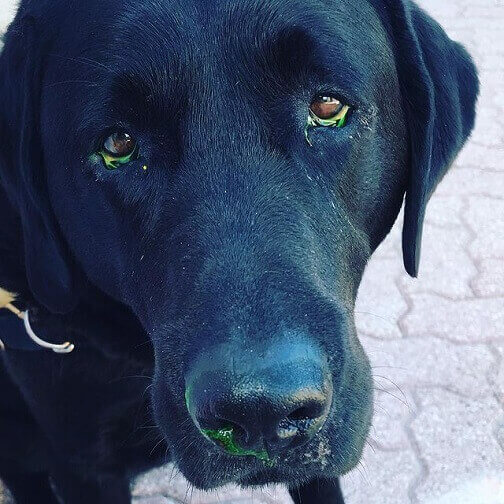
Green or yellow eye discharge can be a sign of conjunctivitis. Kim McLelland/Instagram
Although he obviously cannot tell you that his eyes feel itchy and irritated (which they will if he has conjunctivitis) there are a number of signs that a dog may have pink eye.
These include the following:
- Discharge from the eyes, often yellowish or pale green in color
- Excessive blinking
- Squinting (sign of discomfort)
- Swelling of the eyes
- Redness in the whites of the eyeball
- Pawing at the eyes
- Sneezing and coughing
- Loss of appetite (due to pain)
Many of the symptoms of conjunctivitis can also apply to other infections - especially more serious eye diseases in their early stages - so it is very important that you take your dog to his vet for a check-up as soon as possible, both to relieve his pain and irritation and to prevent more serious, long term damage from occurring.
How is Conjunctivitis in Dogs Diagnosed?
When your vet examines your dog, they'll look for several things to diagnose of conjunctivitis.
A series of diagnostic tests are used to try to determine the underlying cause.
Your vet will try to determine if the problem is an isolated infection - as it would be if it was caused by a bacterial or viral infection or irritation from environmental irritants. They will also rule out that this is not a secondary sign of a more serious condition.
Other conditions to rule out include glaucoma and ulcerative keratitis. This is why it is so important to determine the overall health of the eyes through thorough examination.
It is likely that your vet will perform a standard eye exam, a tear production test (known as the Schirmer tear production test) an eye pressure test to rule out glaucoma and a corneal stain test to ensure there is no damage to the cornea of the eye itself.
Finally, your vet may perform a thorough exam using slit lamp biomicroscopy to better evaluate the eye for potential lesions.
If there is no sign of other disease that may have led to the problem, your vet may also order allergy testing, to determine if there is an environmental component to the infection.
How is Conjunctivitis in Dogs Treated?
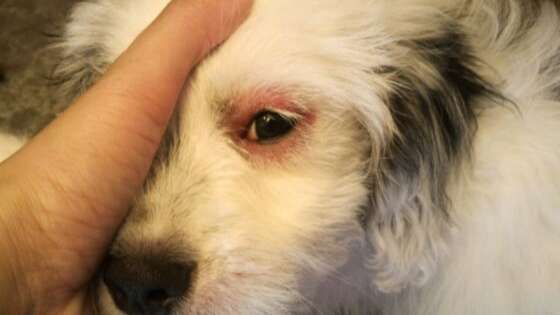
Dog with irritated red eyes from a common allergen such as dust, pollen or mold.
Conjunctivitis is very common in both dogs and cats, but the underlying cause and treatment options can vary greatly.
Simple conjunctivitis treatments
Dogs with simple allergic conjunctivitis can be treated with a topical anti-inflammatory like dexamethasone or prednisolone.
If simple conjunctivitis is diagnosed your dog may be put on a course of antibiotics to clear the infection up. These may be topical in the form of eye drops.
If the dog's eyes have become very swollen, they may also be given anti-inflammatory medications to address that problem. If they have 'dry eye' they will be given medication to stimulate tear production as well.
When conjunctivitis is not the primary abnormality
If the conjunctivitis is determined to be a secondary symptom of another eye disease, that will then be treated as a separate issue.
These treatments will vary depending upon what the diagnosis made is, and may involve visits to and treatment from a veterinary ophthalmologist as well as your regular vet.
Other possible eye infections include: glaucoma, corneal ulceration, intraocular inflammation or an inappropriate tear film in dogs with dry eye.
Note: It should be noted that there are a lot of articles on the Internet that suggest home treating conjunctivitis in dogs with 'home remedies'. It is not a good idea to try and make use of these in lieu of a visit to your vet.
Conjunctivitis will not go away on its own.
By not treating it properly not only will you be forcing your dog to deal with pain and irritation but also risking the long term health of their eyes.
Recovery and Prevention
Most dogs recover very well from conjunctivitis itself and in the short time it takes for the antibiotics to do their thing. If an underlying problem caused the infection it is likely that this will still need to be treated on a long term basis, as is the case with, for example, chronic dry eye.
As prevention is always preferable to cure, most pet parents will want to do all that they can to help prevent their dog from developing, or redeveloping, conjunctivitis.
Some things may be obvious.
If the infection was caused by an allergy, owners will have to take steps to help their dog avoid contact with that allergen.
If the problem was an airborne irritant, then they should be helped to avoid that.
Paying greater attention to your dogs' general eye health is a must no matter what. This includes making sure that their diet is a balanced one that contains the nutrients needed for good eye health. These include beta-carotene, lutein, Vitamins A and C and, in the opinion of some experts, Omega 3 fatty acids as well.
So, the main takeaway to remember about conjunctivitis? Is that it’s not as simple as pet owners might think. Always get diagnostic testing to either rule out something more pertinent or confirm that the disease can be quickly and easily treated.
This quick informational video by Dr. Aimee Beger summarizes conjunctivitis in dogs: causes, symptoms and treatments.

